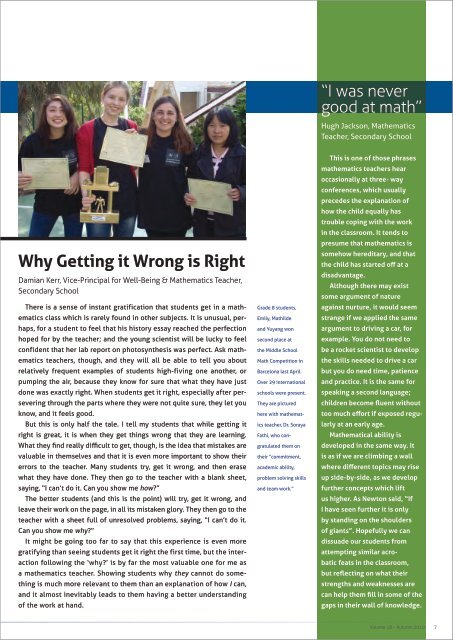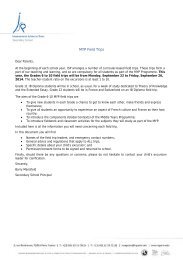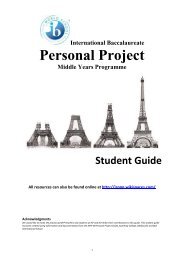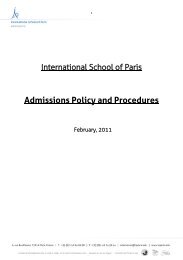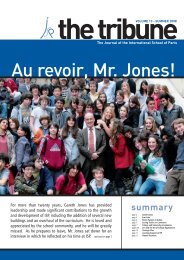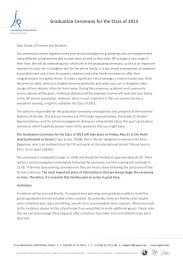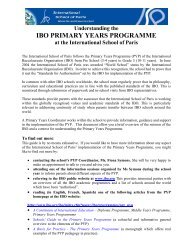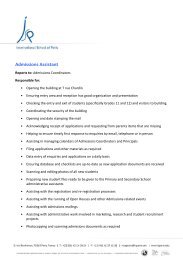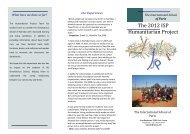The Tribune, Vol. 18 - International School of Paris
The Tribune, Vol. 18 - International School of Paris
The Tribune, Vol. 18 - International School of Paris
- No tags were found...
You also want an ePaper? Increase the reach of your titles
YUMPU automatically turns print PDFs into web optimized ePapers that Google loves.
“I was nevergood at math”Hugh Jackson, MathematicsTeacher, Secondary <strong>School</strong>Why Getting it Wrong is RightDamian Kerr, Vice-Principal for Well-Being & Mathematics Teacher,Secondary <strong>School</strong><strong>The</strong>re is a sense <strong>of</strong> instant gratification that students get in a mathematicsclass which is rarely found in other subjects. It is unusual, perhaps,for a student to feel that his history essay reached the perfectionhoped for by the teacher; and the young scientist will be lucky to feelconfident that her lab report on photosynthesis was perfect. Ask mathematicsteachers, though, and they will all be able to tell you aboutrelatively frequent examples <strong>of</strong> students high-fiving one another, orpumping the air, because they know for sure that what they have justdone was exactly right. When students get it right, especially after perseveringthrough the parts where they were not quite sure, they let youknow, and it feels good.But this is only half the tale. I tell my students that while getting itright is great, it is when they get things wrong that they are learning.What they find really difficult to get, though, is the idea that mistakes arevaluable in themselves and that it is even more important to show theirerrors to the teacher. Many students try, get it wrong, and then erasewhat they have done. <strong>The</strong>y then go to the teacher with a blank sheet,saying, “I can’t do it. Can you show me how?”<strong>The</strong> better students (and this is the point) will try, get it wrong, andleave their work on the page, in all its mistaken glory. <strong>The</strong>y then go to theteacher with a sheet full <strong>of</strong> unresolved problems, saying, “I can’t do it.Can you show me why?”It might be going too far to say that this experience is even moregratifying than seeing students get it right the first time, but the interactionfollowing the ‘why?’ is by far the most valuable one for me asa mathematics teacher. Showing students why they cannot do somethingis much more relevant to them than an explanation <strong>of</strong> how I can,and it almost inevitably leads to them having a better understanding<strong>of</strong> the work at hand.Grade 8 students,Emily, Mathildeand Yuyang wonsecond place atthe Middle <strong>School</strong>Math Competition inBarcelona last April.Over 29 internationalschools were present.<strong>The</strong>y are picturedhere with mathematicsteacher, Dr. SorayaFathi, who congratulatedthem ontheir “commitment,academic ability,problem solving skillsand team work.”This is one <strong>of</strong> those phrasesmathematics teachers hearoccasionally at three- wayconferences, which usuallyprecedes the explanation <strong>of</strong>how the child equally hastrouble coping with the workin the classroom. It tends topresume that mathematics issomehow hereditary, and thatthe child has started <strong>of</strong>f at adisadvantage.Although there may existsome argument <strong>of</strong> natureagainst nurture, it would seemstrange if we applied the sameargument to driving a car, forexample. You do not need tobe a rocket scientist to developthe skills needed to drive a carbut you do need time, patienceand practice. It is the same forspeaking a second language;children become fluent withouttoo much effort if exposed regularlyat an early age.Mathematical ability isdeveloped in the same way. Itis as if we are climbing a wallwhere different topics may riseup side-by-side, as we developfurther concepts which liftus higher. As Newton said, “IfI have seen further it is onlyby standing on the shoulders<strong>of</strong> giants”. Hopefully we candissuade our students fromattempting similar acrobaticfeats in the classroom,but reflecting on what theirstrengths and weaknesses arecan help them fill in some <strong>of</strong> thegaps in their wall <strong>of</strong> knowledge.<strong>Vol</strong>ume <strong>18</strong> – Autumn 2010 7


